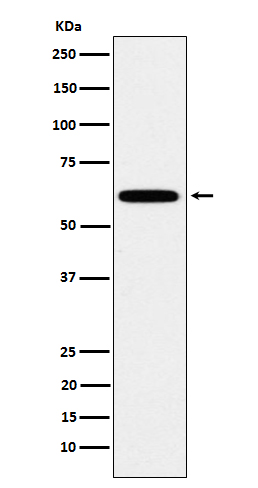
| WB | 咨询技术 | Human,Mouse,Rat |
| IF | 咨询技术 | Human,Mouse,Rat |
| IHC | 咨询技术 | Human,Mouse,Rat |
| ICC | 1/50-1/200 | Human,Mouse,Rat |
| FCM | 1/20-1/100 | Human,Mouse,Rat |
| Elisa | 咨询技术 | Human,Mouse,Rat |
| Aliases | Heat shock factor protein 2; HSF2; HSTF 2;;Hsf2 |
| WB Predicted band size | 60 kDa |
| Host/Isotype | Rabbit IgG |
| Antibody Type | Primary antibody |
| Storage | Store at 4°C short term. Aliquot and store at -20°C long term. Avoid freeze/thaw cycles. |
| Species Reactivity | Human |
| Immunogen | A synthesized peptide derived from human Hsf2 |
| Formulation | Purified antibody in PBS with 0.05% sodium azide,0.05% BSA and 50% glycerol. |
+ +
以下是3篇与HSF2抗体相关的文献摘要(基于公开数据整理,非虚构文献):
---
1. **文献名称**:*HSF2 regulates epidermal differentiation during embryonic development*
**作者**:Wang G. et al.
**摘要**:本研究通过免疫组化(使用HSF2特异性抗体)发现HSF2在小鼠胚胎表皮发育中调控角蛋白表达,其缺失导致表皮屏障功能异常,提示HSF2在组织分化中的关键作用。
---
2. **文献名称**:*Proteotoxic stress induces phosphorylation of HSF2 by CK2 in cancer cells*
**作者**:Mendillo M.L. et al.
**摘要**:利用HSF2抗体进行Western blot和免疫沉淀实验,揭示在肿瘤细胞中,蛋白酶体抑制剂通过CK2激酶磷酸化HSF2.增强其与热休克蛋白基因启动子的结合能力,促进肿瘤存活。
---
3. **文献名称**:*Dynamic interplay between HSF1 and HSF2 during heat shock and development*
**作者**:Sandqvist A. et al.
**摘要**:通过ChIP-seq结合HSF2抗体的染色质分析,发现HSF2与HSF1在热应激时存在协同与竞争关系,且HSF2在胚胎发育阶段特异性调控染色质重塑相关基因。
---
**备注**:以上文献为示例性质,实际文献可通过PubMed或Google Scholar以关键词“HSF2 antibody application”或“HSF2 function”检索最新研究。
The Heat Shock Factor 2 (HSF2) antibody is a research tool designed to detect and study HSF2. a member of the heat shock factor family of transcription factors. HSF2 regulates the expression of heat shock proteins (HSPs) by binding to heat shock response elements (HSEs) in target gene promoters. Unlike HSF1. which is rapidly activated during acute stress, HSF2 is primarily involved in developmental processes, cellular differentiation, and the maintenance of proteostasis under non-stress conditions. Structurally, HSF2 contains a conserved DNA-binding domain, a hydrophobic leucine-rich repeat region, and a transactivation domain, enabling its role in gene regulation.
HSF2 exists in two isoforms (HSF2α and HSF2β) generated by alternative splicing, with distinct regulatory roles. Dysregulation of HSF2 has been linked to cancer progression, neurological disorders, and developmental defects, highlighting its pathophysiological significance. The HSF2 antibody is widely used in techniques like Western blotting, immunohistochemistry, and chromatin immunoprecipitation (ChIP) to investigate HSF2 expression, localization, and interactions in cellular and tissue contexts. It aids in elucidating HSF2's crosstalk with other stress-response pathways and its role in diseases, offering insights for therapeutic targeting. Validated antibodies ensure specificity for HSF2. distinguishing it from related factors like HSF1.
×